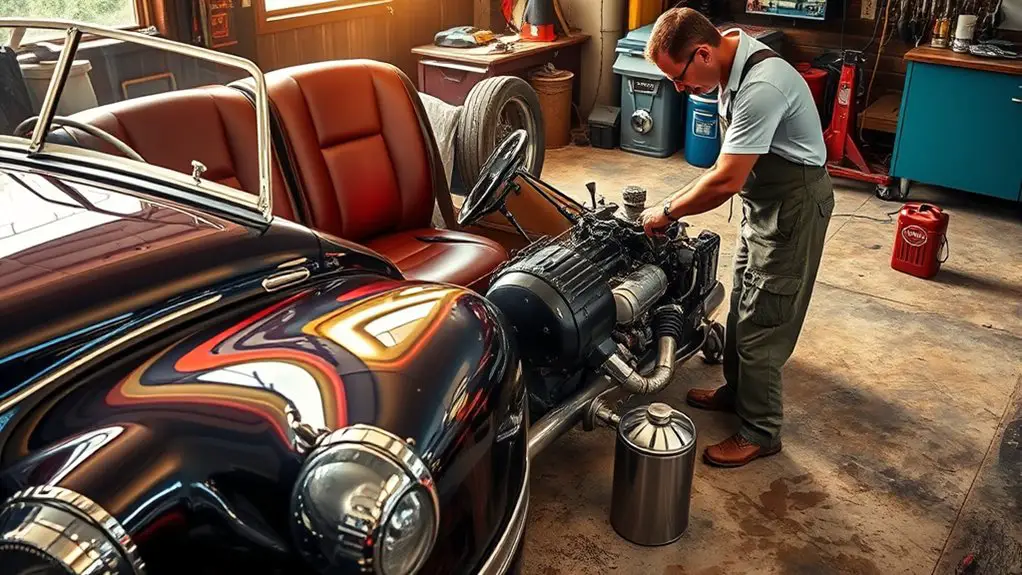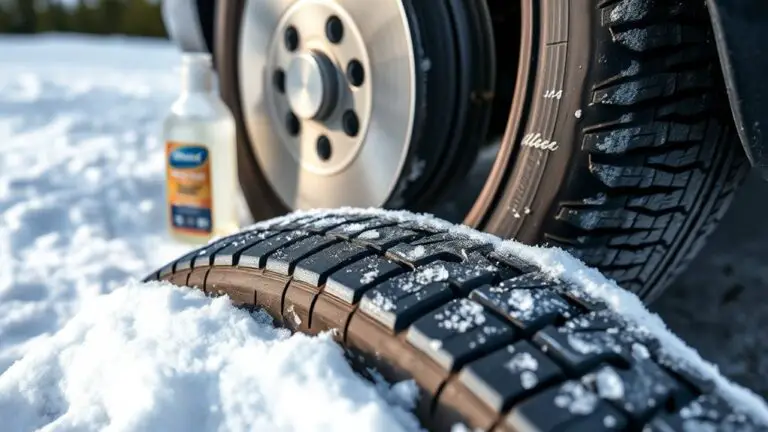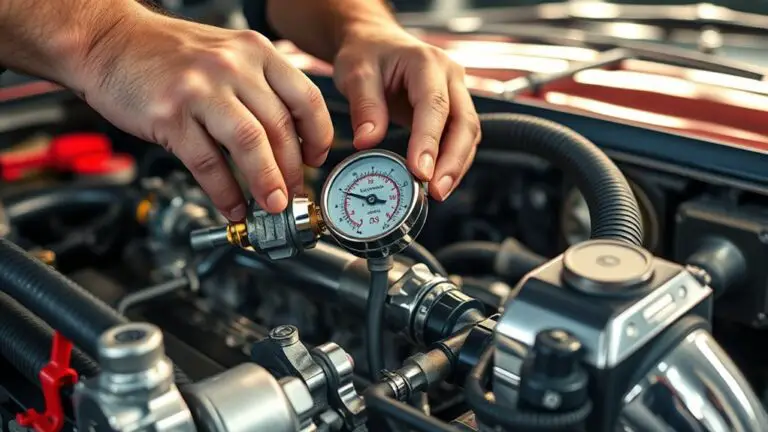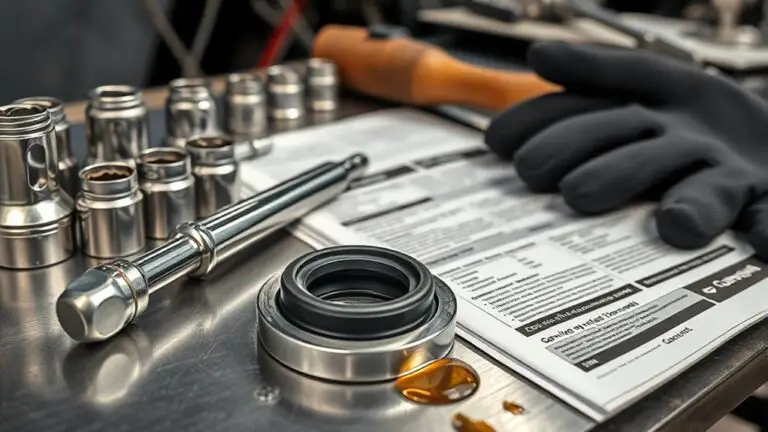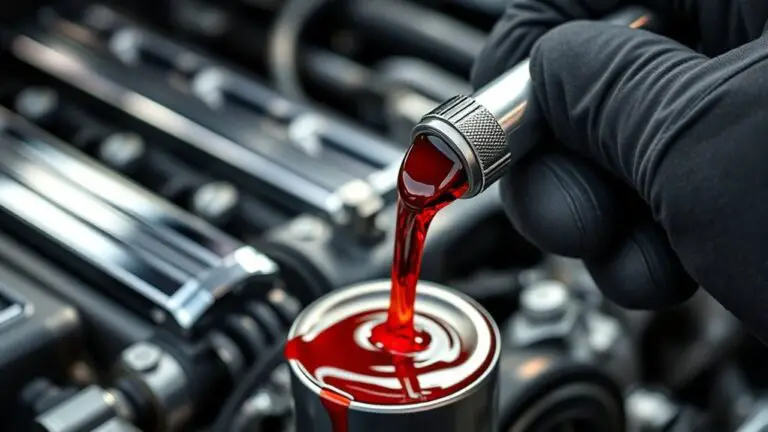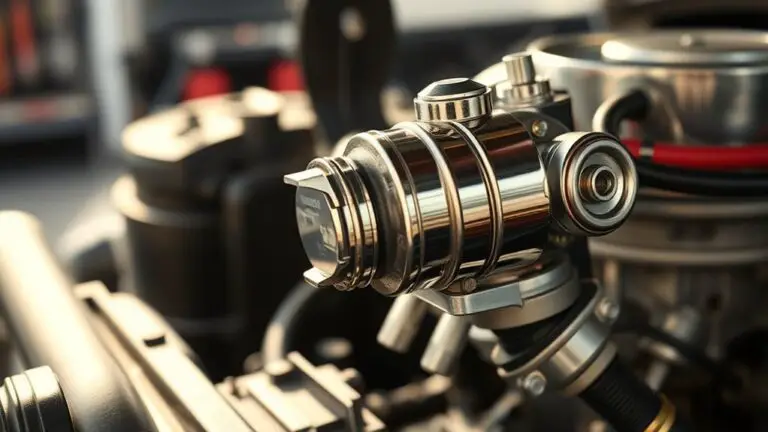Preventive Maintenance to Avoid Transmission Overheating in Older Classic Car
To prevent transmission overheating in your classic car, routinely check and change the transmission fluid, ensuring you use the correct type. Inspect the cooling system regularly for fan operation and radiator integrity. Consider upgrading components like the torque converter and cooler for better performance. Monitor your driving habits, focusing on smooth acceleration and avoiding prolonged idling. Implementing these practices can help maintain peak transmission health, and you’ll discover more ways to enhance your vehicle’s reliability.
Understanding Transmission Overheating
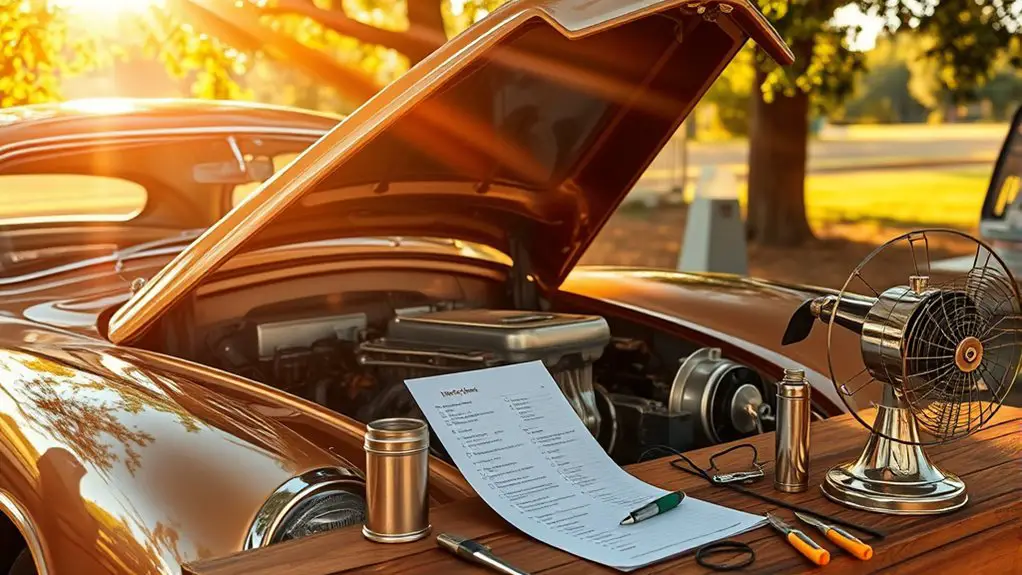
When you’re driving a classic car, your transmission’s health is essential, especially since it can be prone to overheating. Understanding the different transmission types—automatic, manual, and semi-automatic—can help you identify how heat affects each system. Overheating can stem from several heat causes, including low fluid levels, insufficient cooling, or excessive load.
For instance, an automatic transmission relies heavily on fluid circulation for cooling, making it vulnerable to heat buildup if the fluid’s insufficient or degraded. Manual transmissions, while typically more robust, can also suffer if not properly managed under heavy acceleration or towing conditions.
To maintain ideal performance, be mindful of how driving habits and environments contribute to heat generation. Recognizing these factors can empower you to take proactive steps, ensuring your classic car’s transmission remains in peak condition, allowing you the freedom to enjoy the open road without worry.
Regular Fluid Checks and Changes
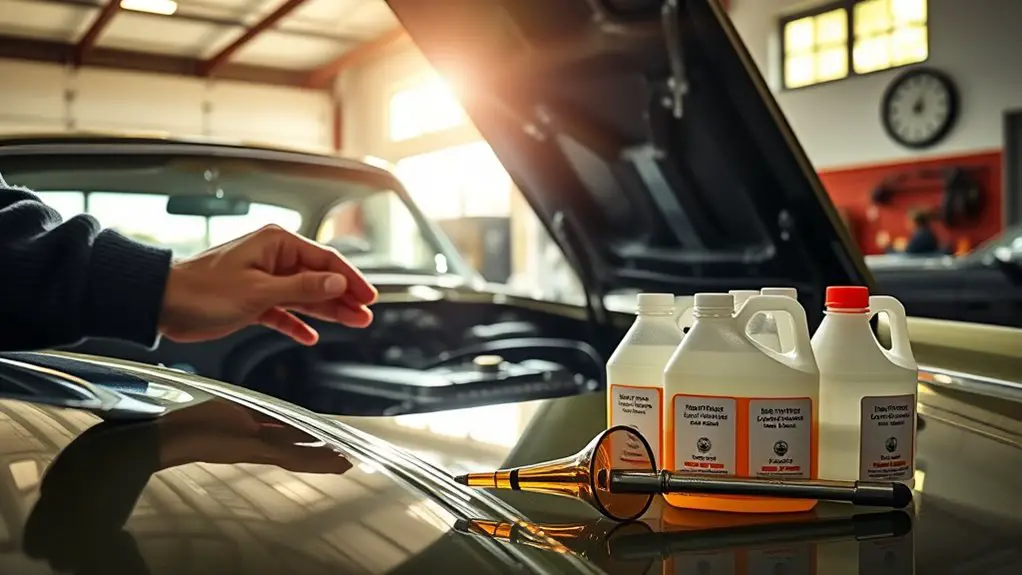
Regular fluid checks and changes are essential for maintaining the performance and longevity of your classic car’s transmission. Start by identifying the correct fluid types recommended for your specific model; using the wrong fluid can lead to serious issues. Typically, automatic transmissions require ATF, while manual transmissions might need gear oil. Check the fluid level regularly, ensuring it’s within the manufacturer’s specified range.
Change intervals vary, but a good rule of thumb is every 30,000 to 60,000 miles, or as specified in your owner’s manual. During fluid changes, inspect for contaminants or discoloration, which can indicate overheating or wear. Always replace the transmission filter if applicable, as it helps trap debris and maintain fluid cleanliness. By staying on top of fluid checks and changes, you’ll not only enhance your transmission’s efficiency but also prevent overheating and costly repairs down the road.
Inspecting and Maintaining Cooling Systems

Cooling systems are essential for preventing overheating in classic cars, ensuring that your engine operates within the ideal temperature range. To keep your vehicle running smoothly, regular inspection and maintenance are critical. Begin by checking the cooling fan’s operation; it should engage when the engine reaches a specific temperature. Radiator maintenance is also fundamental—look for leaks, corrosion, or blockages that can impede performance.
| Component | Inspection Frequency | Common Issues |
|---|---|---|
| Cooling Fan | Every 3 months | Failure to engage |
| Radiator | Every 6 months | Leaks, corrosion |
| Hoses | Annually | Cracks, wear |
| Thermostat | Annually | Sticking open/closed |
| Coolant Level | Monthly | Low levels, contamination |
Upgrading Transmission Components
Upgrading transmission components can greatly enhance your classic car’s performance and reliability, especially if you’re aiming for improved power delivery and shifting responsiveness. Consider installing a high-performance torque converter; it can maximize the engine’s power band, allowing for quicker acceleration and smoother shifts. Additionally, upgrading to a heavier-duty transmission cooler will help maintain ideal fluid temperatures, preventing overheating during spirited drives.
You might also explore aftermarket valve bodies, which can provide firmer shifts and improved fluid routing, enhancing overall efficiency. Don’t overlook the benefits of stronger bands and clutches; these transmission upgrades can handle increased power and torque without slipping.
For best results, verify that all components are compatible with your existing system. These performance enhancements not only improve driving dynamics but also contribute to the longevity of your transmission, making sure your classic car remains a joy to drive for years to come.
Monitoring Driving Habits
Monitoring driving habits is essential for maintaining the health and performance of your classic car. By adopting effective driving techniques and adhering to speed regulation, you can greatly reduce the risk of transmission overheating. Here are some key practices to keep in mind:
Effective driving habits are crucial for preserving your classic car’s performance and preventing transmission overheating.
- Smooth acceleration and deceleration: Avoid rapid starts and stops, which can strain your transmission and lead to overheating.
- Maintain a consistent speed: Using cruise control on highways helps maintain a steady engine temperature and reduces stress on your transmission.
- Avoid excessive idling: Prolonged idling can cause the transmission fluid to overheat, so turn off the engine if you’re parked for an extended period.
Seeking Professional Inspections and Repairs
Even with careful attention to driving habits, regular professional inspections and repairs are essential for the longevity of your classic car. To guarantee your transmission remains in peak condition, seek expert consultations that focus on tailored maintenance strategies. Professionals can perform thorough transmission diagnostics, identifying potential issues before they escalate into costly repairs.
During inspections, they’ll evaluate fluid levels, check for leaks, and assess the overall performance of the transmission system. This proactive approach not only enhances your car’s reliability but also preserves its value.
Additionally, keeping records of these inspections allows you to track the history of your vehicle, providing insight into its needs over time. Your freedom on the road depends on the health of your transmission, so don’t overlook the benefits of expert assessments. Investing in professional care now can save you from significant headaches later on.
Frequently Asked Questions
How Often Should I Check My Transmission Fluid Levels?
You should check your transmission fluid levels every 30,000 miles or at least twice a year for ideal fluid maintenance. Regularly reviewing this essential vehicle element guarantees proper transmission care, preventing potential problems. Look for signs of discoloration or unusual smells during your inspection. Staying proactive with your fluid checks not only enhances performance but also promotes the freedom of a smoothly running classic car, allowing you to enjoy every drive without worries.
Can I Use Synthetic Fluid in My Classic Car’s Transmission?
Yes, you can use synthetic fluid in your classic car’s transmission, but verify it’s compatible with your specific model. Synthetic fluids offer several benefits, like better heat resistance and improved lubrication, which can enhance performance. However, older transmissions may require specific formulations to avoid compatibility issues. Always consult your owner’s manual or a knowledgeable mechanic to ascertain you’re making the right choice for your classic vehicle’s needs. Enjoy the drive!
What Symptoms Indicate My Transmission Is Overheating?
If your transmission’s overheating, you’ll notice symptoms like a transmission warning light, slipping gears, or unusual smells, such as burning fluid. You might also experience delayed shifting or increased difficulty in changing gears. Overheating causes can include low fluid levels, old fluid, or a malfunctioning cooling system. It’s essential to address these signs promptly to prevent serious damage and maintain your vehicle’s performance and freedom on the road.
Is It Safe to Drive an Overheating Transmission?
No, it’s not safe to drive an overheating transmission. Can you really risk damaging your vehicle? Under extreme driving conditions, an overheating transmission can lead to catastrophic failure, jeopardizing both performance and safety. If your transmission’s temperature exceeds the recommended limit, you should stop driving immediately. Continuing to drive can result in severe damage, costly repairs, and might even compromise your overall driving safety. Always prioritize transmission safety to guarantee a smooth and reliable ride.
What Are the Long-Term Effects of Transmission Overheating?
If your transmission overheats, you’re risking serious long-term damage. Overheating leads to fluid degradation, which can compromise lubrication and increase wear on internal components. This can result in costly transmission repair down the line. As parts wear out, you might experience slipping, shifting issues, or complete failure. It’s essential to monitor temperatures and maintain fluid quality to guarantee your vehicle runs smoothly and to preserve the freedom that comes with classic car ownership.

